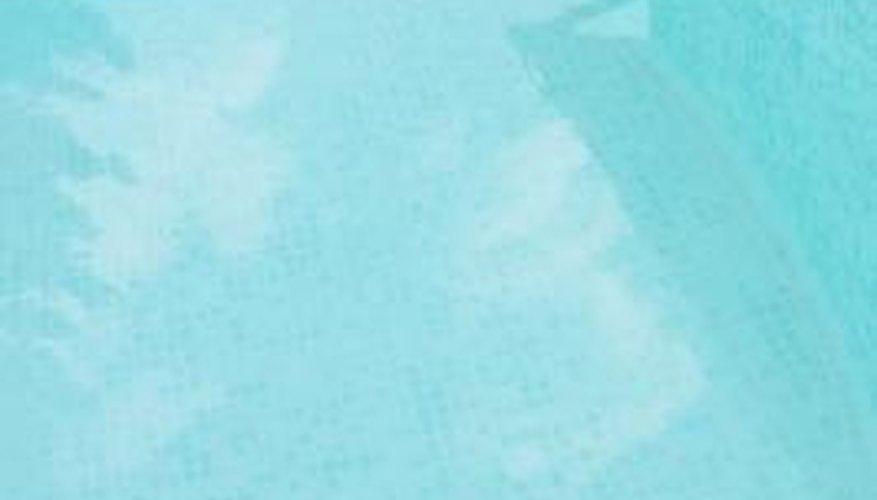Swimming pool owners wishing to avoid adding chlorine by spreading it around their pool have the option of using pool chlorine tablets. Pool chlorine tablets are placed in a pool chlorinating device or a floating basket, where they will slowly dissolve over time. How long pool chlorine tablets take to dissolve, though, depends on their size. Additionally, pool chlorine tablets dissolve in shorter or longer amounts of time depending on the amount of fillers and binders within them.
Dissolve times
Pool chlorine tablets come in 2.5 cm and 7.5 cm (1 inch and 3 inch) sizes and dissolve very slowly if properly used in a swimming pool. Typically, a 7.5 cm (3 inch) pool chlorine tablet is designed to chlorinate from 33,750 to 45,000 litres (7,500 to 10,000 gallons) of water per week, meaning it'll take seven days to dissolve. If you have a 135,000 litre (30,000 gallon) pool, you'll need to place three 7.5 cm (3 inch) pool chlorine tablets in a chlorinator or floater. Water moving over chlorine tablets, as in a chlorinator, causes them to dissolve more quickly.
- Pool chlorine tablets come in 2.5 cm and 7.5 cm (1 inch and 3 inch) sizes and dissolve very slowly if properly used in a swimming pool.
- If you have a 135,000 litre (30,000 gallon) pool, you'll need to place three 7.5 cm (3 inch) pool chlorine tablets in a chlorinator or floater.
Chlorine tablets
Pool chlorine tablets are used by many swimming pool owners because they're very convenient. They're small, easy to store and you don't have to "broadcast" or spread them all over a swimming pool. By using chlorine tablets in a swimming pool, an owner is able to avoid having to add chlorine on a more frequent basis than once or twice per week. Chlorine strength in chlorine tablets is also very high at 90 per cent by volume.
- Pool chlorine tablets are used by many swimming pool owners because they're very convenient.
Tablet acidity
Because of the chlorine used in pool chlorine tablets (Trichloro-S-Triazinetrione, or "trichlor"), their acidity is very low. By contrast, granular calcium hypochlorite pool chlorine is highly alkaline. The reason trichlor tablets are acidic is because they're stabilised and made of a salt of cyanuric acid (CA). CA is a very effective chlorine stabiliser that prevents sunlight from dissipating pool chlorine too quickly. However, trichlor tablets lower a pool's pH, so they need to be monitored and raised on a periodic basis.
- Because of the chlorine used in pool chlorine tablets (Trichloro-S-Triazinetrione, or "trichlor"), their acidity is very low.
- The reason trichlor tablets are acidic is because they're stabilised and made of a salt of cyanuric acid (CA).
Considerations
Pool chlorine tablets in a pool floater will dissolve slower than those put in a chlorinator. Also, remove the pool's floater prior to swimming, as chlorine levels near the floater could be quite high. Handle pool chlorine tablets with care and avoid placing them in a pool's skimmer. Lastly, keep pool chlorine levels between 1 and 2 parts per million (ppm), which chlorine tablets are designed to deliver when used correctly.
- Pool chlorine tablets in a pool floater will dissolve slower than those put in a chlorinator.
- Lastly, keep pool chlorine levels between 1 and 2 parts per million (ppm), which chlorine tablets are designed to deliver when used correctly.
pH issues
If you find that your pool chlorine tablets have lowered your swimming pool's pH below 7.2, you can raise it by adding sodium carbonate (soda ash). Adding soda ash to a pool will increase its alkalinity. It takes from 0.9 to 2 kg (2 to 4.5 lbs) of soda ash in 135,000 litres (30,000 gallons) raise pool pH back up to 7.2, depending on how low pH levels are to start. When swimming pool pH is below 7 available chlorine disappears, leaving pools vulnerable to contamination.
- If you find that your pool chlorine tablets have lowered your swimming pool's pH below 7.2, you can raise it by adding sodium carbonate (soda ash).
